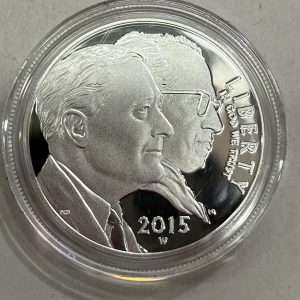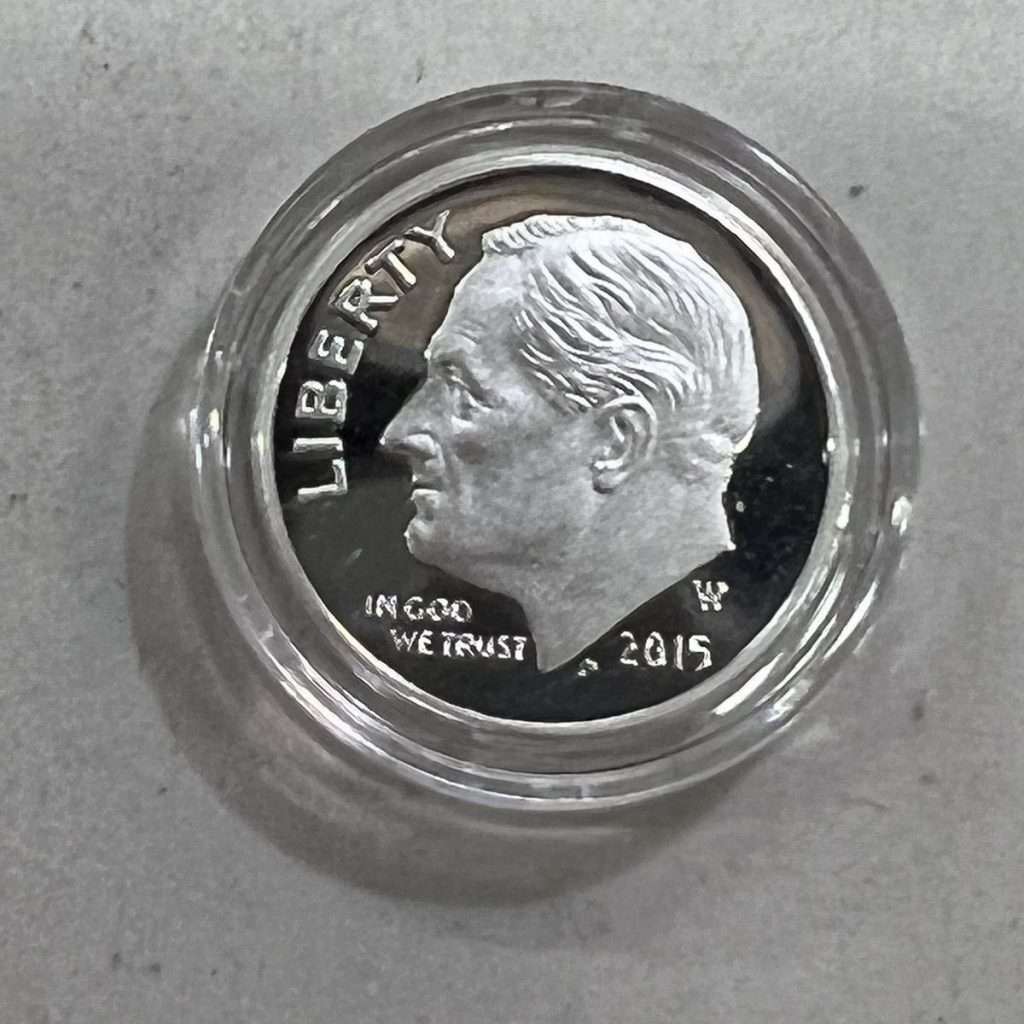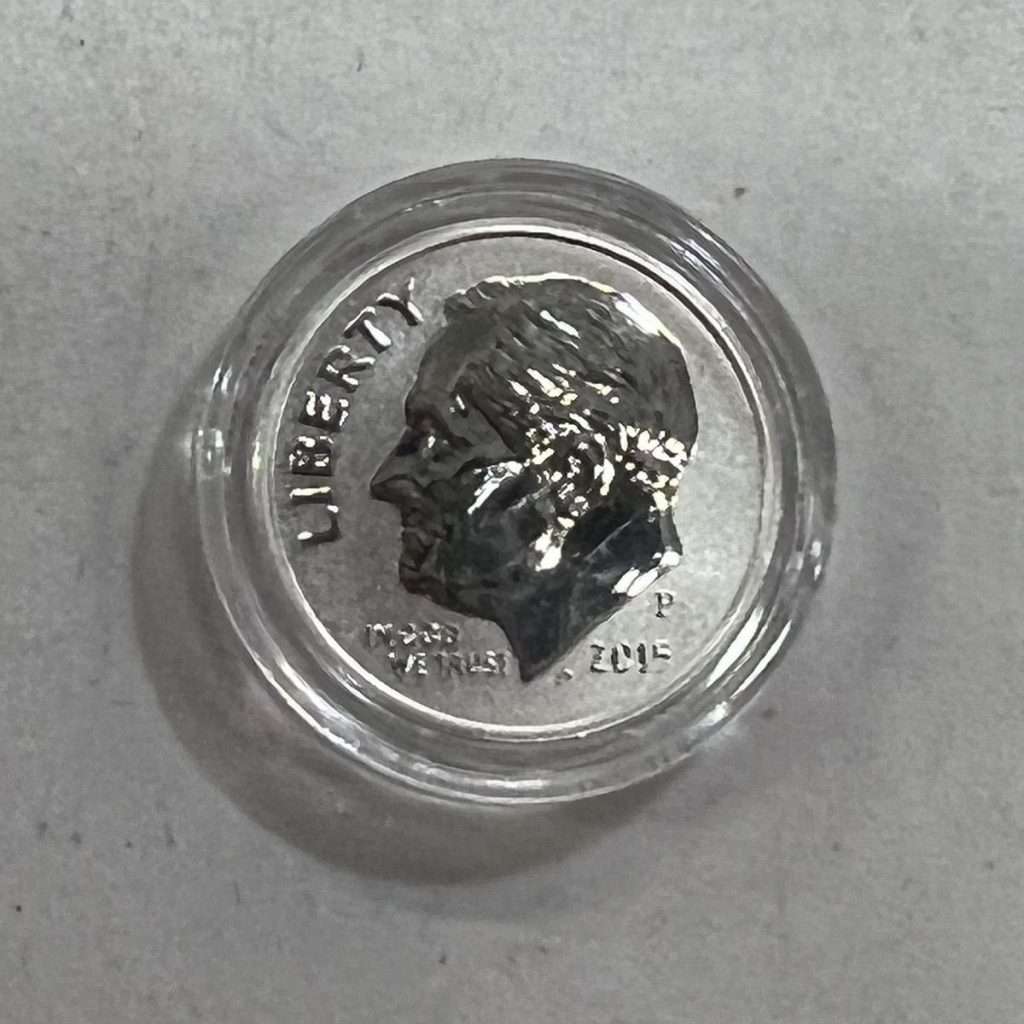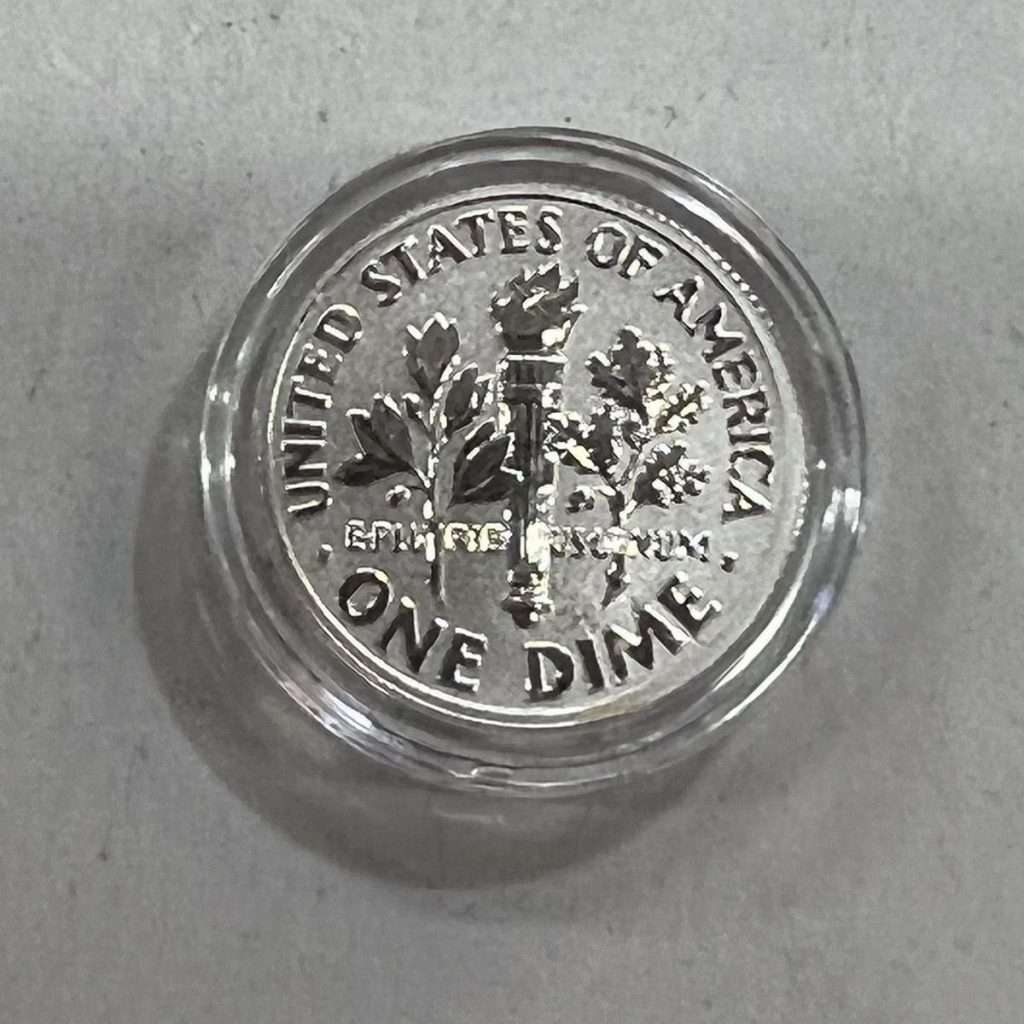May 8, 2022 | coins, commentary, news
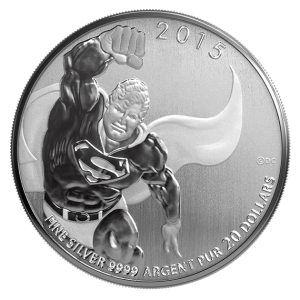
Reverse of the Royal Canadian Mint 2015 Superman $20 for $20 coin featuring “The Man of Steel”
After reading yesterday’s blog post, the comics dealer asked me how to become a coin dealer to sell comics-themed coins.
My reader knows that the comics industry is exploding and that the publishers are dabbling in non-fungible tokens (NFT) to see if they can extend the market. Those skeptical of the NFT market are looking for alternatives. A comics dealer that expanded to other publications, toys, and other collectibles understands that extending his market with coins will be profitable.
Walk into any hobby shop and see how every hobby has evolved. Comics, sports, and antiques have seen a rise in collecting, and all have seen the benefit of cross-collecting. A sports dealer is also selling comics and other collectibles with sports themes. Comics dealers are collectible cards and souvenirs from the ComicCons, the same as the sports dealers are selling game tickets.
Coin dealers extend their business into metals and jewelry, and their stores look the same as they did 10 years ago. The dealers may be making a living, but it is not expanding the hobby. But is it their job to expand the hobby or make a living? Unfortunately, this attitude is typical with the dealers trying to set ANA policy and is not helping the hobby’s growth.
And now the news…

May 4, 2022
The most successful artistic design of the Croatian national side of the €1 coin has been selected, the Croatian National Bank (HNB) said in a press release.

→ Read more at
croatiaweek.com

May 5, 2022
Found in Switzerland, some of the buried Roman coins were minted during a time of relative political stability, between 332 and 335 C.E.

→ Read more at
smithsonianmag.com
May 7, 2022 | coins, commentary

Cover with the 2015 $20 Canada Superman coin
Free Comic Book Day is more than an effort to get people into the stores to buy comics. The publisher will take the opportunity to tweak a story, start a new story arc, or introduce new characters. They spend a few pages in the free comic book to enhance their stories or introduce new characters. The free comic book may also have an existing story that can summarize the story to convince readers to start reading the series.
Free Comic Book Day is more than a giveaway day. It is a marketing tool for the story writers to interact with the readers and get them attracted to the stories. The publishers and store owners use the giveaway to keep current customers interested and lure in new customers.
Although the publishers will introduce many new stories and characters, almost 90-percent will not last more than a few issues. The publishers know this and are willing to try whatever it takes to ensure that the readers come back for more. Once the readers are hooked, the publishers extend the brand into movies and other collectibles where collectors can purchase the merchandise anywhere.
The comic book industry accomplishes more in one day than the numismatic industry accomplishes in one week. Considering how ubiquitous money is in society, It is any wonder that we can raise new collectors.
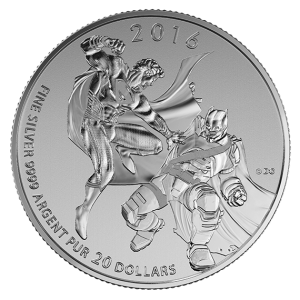
2016 Canada Batman v Superman: Dawn of Justice $20 silver coin
There is nothing wrong with comics and the comics culture. Comics readers love their characters, especially the superheroes, that they extend their buying beyond the comic book. Why not invite them into your shop to add comic book character coins to their collection.
You may not find coins with Superman, Batman, Captain America, or Spider-man exciting coins, but they are legal tender coins made of silver or gold that excite this crowd. Contact the publishers and see if you can source material to supplement the coins. It could create a partnership that could benefit both collectibles.
It might not be selling rare proof-like Morgans, but it will get people in your shop to look at your other inventory. Maybe they will see the Buffalo nickels and think those Type 1 coins are so cool that they might start a collection.
I have an idea… on Free Comic Book Day, the numismatic community can work with Marvel and DC to create a brass token that would be available to the collecting public. Some to the coin store, get the token for free. Let the publishers work on tokens and medals associated with their comics and sell them through coin stores. Then the coin stores can contact the New Zealand Mint or the Royal Canadian Mint to purchase a supply of comic book character coins and join the fun.
May 6, 2022 | coins, quarter
 The current quarter in the American Women Quarters Program honors Dr. Sally Ride. These coins are showing up in change in an increasing number, with several landing in my pocket this week.
The current quarter in the American Women Quarters Program honors Dr. Sally Ride. These coins are showing up in change in an increasing number, with several landing in my pocket this week.
Dr. Ride was a physicist, astronaut, educator, and the first American woman to rocket into space aboard the Space Shuttle Challenger in 1983. At 32, Ride was also the youngest American in space.
On STS-41G in 1984, also on the Challenger, Ride was joined by Dr. Kathryn Sullivan, a geologist, making it the first space mission with two female crew members.
Following her retirement from NASA, Ride and Tam O’Shaughnessy teamed up to write science books for young people. They also started an educational company to inspire young people, especially girls, in science, technology, engineering, and math (STEM).
Ride received many honors during her life, including induction into the Astronaut Hall of Fame, National Women’s Hall of Fame, and Aviation Hall of Fame.
The reserve depicts Dr. Sally Ride next to a window on the space shuttle. It was designed by Elana Hagler of the Artistic Infusion Program and sculpted by U.S. Mint Medallic Artist Phebe Hemphill.
May 5, 2022 | commemorative, legislative

James Weldon Johnson (Photographed by Carl Van Vechten, 1932)
James Weldon Johnson was a writer and civil rights activist who was a leader of the NAACP. In 1920, Johnson was chosen as the first African-American executive secretary of the NAACP, effectively becoming its chief operating officer.
Johnson was known for his writing about black culture during the Harlem Renaissance. His work includes the lyrics for “Lift Every Voice and Sing,” which later became known as the Negro National Anthem. The music was written by his younger brother, J. Rosamond Johnson.
Johnson’s other accomplishments include his appointment as the U.S. consul in Venezuela and Nicaragua by Theodore Roosevelt, the first African-American professor hired by New York University, and later became a professor at Fisk University.
If this bill becomes law, 85-percent of the surcharges will be divided equally between the Marshall-Motley Scholars Program, the Stanton College Preparatory School, and the National Association for the Advancement of Colored People (NAACP). The rest of the money will be given to the James Weldon Johnson Foundation.
H.R. 7469: James Weldon Johnson Commemorative Coin Act
Introduced in House — Apr 7, 2022
Referred to the House Committee on Financial Services. — Apr 7, 2022
May 4, 2022 | ANA, commentary
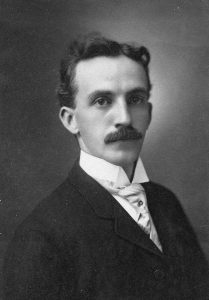
Faran Zerbe ca. 1908
In early 2021, the Board voted to remove Faran Zerbe’s name from the award based on unproven accusations. Based on the Board’s statement, they accused Zerbe of “hucksterism and fraud” for a collectible created in 1904 for the Louisiana Purchase Expo. However, contemporary accounts do not support this accusation, and Zerbe went on to serve as head numismatist for the expositions in 1905 (Portland) and 1915 (San Francisco).
The Board also accused Zerbe of “unscrupulously obtained personal ownership of The Numismatist in 1908 from relatives of the ANA’s late founder, Dr. George F. Heath.” Their statement even said it was an “allegation” and has never provided documentation to confirm their allegations.
It is difficult to argue against creating an award for Chet Krause, and his work and dedication to the ANA and the hobby deserve an honor. But honoring Krause should NOT diminish the contribution of Zerbe, and the ANA should have created a separate award or renamed the award the Zerbe-Krause Distinguished Service Award.
Instead of joining the politically correct “woke” crowd, the ANA Board of Governors should be working on ways to expand the association’s reach and impact. There is so much the Board can do to better the ANA than play these games.
May 1, 2022 | BEP, currency, news
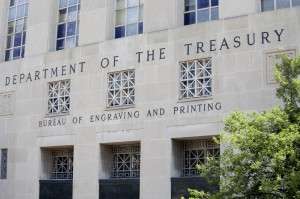 The Bureau of Engraving and Printing announced that they negotiated a transfer of land from the U.S. Department of Agriculture to build a new facility in the Maryland suburbs of Washington, D.C.
The Bureau of Engraving and Printing announced that they negotiated a transfer of land from the U.S. Department of Agriculture to build a new facility in the Maryland suburbs of Washington, D.C.
The USDA will transfer the 104-acre Beltsville Agricultural Research Center northwest of the Capital Beltway for the new printing facility. The BEP plans to begin construction in 2023 and complete the facility by 2027. The new printing facility will employ at least 850 people.
The BEP used to be the security printer for the United States government. The BEP printed security documents, including bonds and deed certificates, and stamps, other than printing currency.
Legally, the primary mission of the BEP is to print currency for the Federal Reserve. They would offer other printing services as long as they continued to supply the Fed with currency. Beginning in the 1970s, the BEP reduced the number of stamps they printed until ending stamp printing in the early 1990s. When the Treasury ended the Series E savings bond program, they contracted printing to other contractors.
The economic expansion of the 1980s led the BEP to end almost all security printing to print currency. Before opening the Fort Worth printing center in 1991, Treasury officials explored using commercial printers to supplement the BEP’s capabilities.
In 2022, the Federal Reserve ordered the printing of over 6.9 billion notes. Although this is less than last year’s order, the BEP is approaching its maximum capacity between the Washington and Fort Worth sites. And even though bonds and stamps have become electronic assets, the U.S. government still has a security printing requirement. Although a source at the BEP would not elaborate on the printing requirement, they said that government officials want to make security printing a government function.
And now the news…

April 27, 2022
It will house a new state-of-the-art and environmentally conscious production facility to print U.S. paper currency and other federal security products.

→ Read more at
nbcwashington.com

April 30, 2022
COIN collecting was once a hobby for Stephanie Sabin – now she lives her dream by steering the ship for a major grading service firm. Mrs Sabin, who is the president of Professional Coin Grading Services (PCGS), has been into collecting since she was a child thanks to her family’s numismatic background.

→ Read more at
the-sun.com
Apr 24, 2022 | coin design, coins, news
I am sponsoring
GOLD memberships for new and renewing memebers of the American Numismatic Association. This is a limited-time offer to celebrate
National Coin Week and the 131st anniversary of the American Numismatic Association. The offer expires on April 25, 2022. Call (800) 514-2646 or visit
info.money.org/ncw-2022-barman to take advantage of this offer. Be sure to apply code
NCW22SB at checkout!
 National Coin Week wraps up this weekend, celebrating coin designs. One thing that has been constant throughout the 21st century is changing coin designs. It started with the 50 State Quarters program and has affected every circulating coin except the half-dollar and the dime.
National Coin Week wraps up this weekend, celebrating coin designs. One thing that has been constant throughout the 21st century is changing coin designs. It started with the 50 State Quarters program and has affected every circulating coin except the half-dollar and the dime.
Although the design has lasted more than 25 years, it is not likely that the Treasury Department will change the design. The story of the JFK assassination continues to resonate with a significant sector of the population, and Kennedy’s popularity remains.
Franklin D. Roosevelt’s appearance on the dime is different. Roosevelt helped create the March of Dimes, and following his death, Congress decided that adding his portrait to the dime was the best way to honor the late president. Since its release in 1946, the dime’s design has not changed.
The Roosevelt Dime is the smallest coin produced by the U.S. Mint. Changes to the design may not display as well. When John Sinnock designed the coin’s reverse, the similarity with the Mercury dime was not a coincidence. Aside from the symbolism, the U.S. Mint knows the design will strike well on a small planchet.
While the ability to strike the designs continues to be a concern, modern technology could help produce a suitable design. The problem is, what would make an appropriate design?
Until someone in Congress proposes a bill to change the dime’s design, it will remain the longest-running design on U.S. coins.
And now the news…

April 17, 2022
“The Romans had been used to extremely fine silver coinage, so they may well have lost confidence in the denarius when it ceased to be pure,” Matthew Ponting, one of the archaeologists involved in the research, said in a media statement.

→ Read more at
mining.com

April 17, 2022
An approximate amount of $1 has been received. The U.S. economy is estimated to grow by $5 trillion over the next five years. Coins with physical characteristics. The 11th quarter accounts for about 80% of this value. A billion-dollar note is $100 worth 5 billion. 70 percent of new bills are written to replace older notes as they go out of circulation each year.

→ Read more at
malaysiandigest.com

April 18, 2022
Nearly 1,300 priceless 4th-century AD Roman coins, all in a pot, were found in September 2021 near Bubendorf, Basel County, Switzerland by amateur archaeologist volunteer, Daniel Ludin.

→ Read more at
ancient-origins.net

April 20, 2022
A family's new truffle-hunting puppy is already worth its weight in gold after digging up 15 sovereign coins worth £6,000 on its first walk.

→ Read more at
dailymail.co.uk

April 22, 2022
Out on his daily constitutional, a dog in Poland unexpectedly struck gold, or rather, silver.

→ Read more at
ancient-origins.net
Apr 22, 2022 | coin design, commemorative, silver
I am sponsoring
GOLD memberships for new and renewing memebers of the American Numismatic Association. This is a limited-time offer to celebrate
National Coin Week and the 131st anniversary of the American Numismatic Association. The offer expires on April 25, 2022. Call (800) 514-2646 or visit
info.money.org/ncw-2022-barman to take advantage of this offer. Be sure to apply code
NCW22SB at checkout!
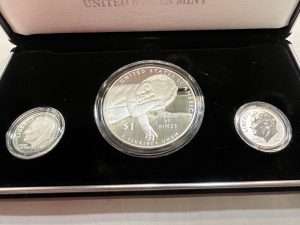 Since National Coin Week is celebrating coin designs, we can recognize that the coin design can be a factor in collecting the coin. Let’s look at a coin in my collection only because of its design.
Since National Coin Week is celebrating coin designs, we can recognize that the coin design can be a factor in collecting the coin. Let’s look at a coin in my collection only because of its design.
Commemorative coins are a fundraising mechanism. An organization convinces a member of Congress to submit a bill to create a commemorative coin that will raise money. The authorizing legislation usually is tied to a milestone, even if it is late, so there is something to promote.
Although people collect commemorative coins, I collect those with subjects that interest me. But there was one commemorative coin I purchased because of the design. My collection includes the 2015 March of Dimes Commemorative Coin Set because of the coin’s design.
Produced for the celebration of the March of Dimes Foundation’s 75th anniversary, the design is a phenomenal work of art. It is the most appropriate image for any modern commemorative coin.
President Franklin D. Roosevelt created the National Foundation for Infantile Paralysis, now called the March of Dimes) in 1938 to fund research to cure polio. FDR fought the painful effects of polio throughout his life. After Drs. Jonas Salk and Albert Sabin developed a very effective vaccine, the Foundation changed its mission to prevent birth defects, prematurity, and infant mortality.
Fortunately, my family has not been touched by the issues that March of Dimes looks to correct, but it is a worthy cause to champion. Otherwise, it is not something that has personal meaning. But the reverse design is compelling.
The reverse was designed by Don Everhart and described on the U.S. Mint’s website, “The reverse (tails) design depicts a baby cuddled in the hand of a parent, representing the foundation’s dedication to the health of babies everywhere.” It is one of the most powerful images on a commemorative coin.
When I decided to add a version to my collection, I waited until the commemorative silver set was available. The set contains the commemorative silver dollar, a proof Roosevelt Dime, and a reverse-proof Roosevelt Dime. It was the reverse-proof dime that made the set attractive. The best-looking coins of the last ten years were reverse-proof and enhanced uncirculated coins.
Although the reverse proof and enhanced uncirculated are in the manufacturing processes, the final results highlight the coin’s design in a way that could not happen with any other process.
This set is included in my collection because of the phenomenally inspirational design of the reverse of the commemorative silver dollar and the reverse-proof silver dime.
All images are original and property of the author used under the Creative Commons license
CC BY-NC-SA 4.0.
Apr 21, 2022 | Canada, coins, commemorative
I am sponsoring
GOLD memberships for new and renewing memebers of the American Numismatic Association. This is a limited-time offer to celebrate
National Coin Week and the 131st anniversary of the American Numismatic Association. The offer expires on April 25, 2022. Call (800) 514-2646 or visit
info.money.org/ncw-2022-barman to take advantage of this offer. Be sure to apply code
NCW22SB at checkout!
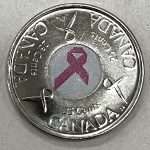
2006 Canada 25-cents Pink Ribbon coin
The Royal Canadian Mint issued the 2004 Remembrance Day poppy 25-cents coin, the world’s first colorized circulating coin. The RCM produced 30 million coins featuring a red poppy on the reverse. The RCM expanded the program in 2008 for the 90th anniversary of the end of World War I with other collectibles.
In 2006, the RCM partnered with the Canadian Breast Cancer Foundation to create a pink ribbon colorized coin. The pink ribbon is the symbol of hope and awareness for breast cancer. Talking about breast cancer also brings awareness to all cancers.
According to the National Cancer Institute, one-in-three people have been diagnosed with cancer or a direct relative diagnosed with cancer. Cancer is the second leading cause of death in the United States, and my family was reduced by someone who died of cancer, including my first wife.
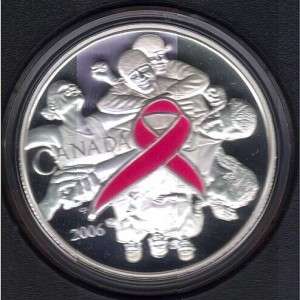
2006 Breast Cancer Silver Coin with colored pink ribbon.
My story is also a reminder that you do not have to collect in the way others recommend. You do not have to fill blue, brown, or green books with coins or the lists produced by someone else, and you can collect based on the topics that mean something to you. Go out and enjoy your collection!
All images are original and property of the author used under the Creative Commons license
CC BY-NC-SA 4.0.
Apr 19, 2022 | ANA, bicentennial, coins, dollar, halves, quarter, US Mint
I am sponsoring
GOLD memberships for new and renewing memebers of the American Numismatic Association. This is a limited-time offer to celebrate
National Coin Week and the 131st anniversary of the American Numismatic Association. The offer expires on April 25, 2022. Call (800) 514-2646 or visit
info.money.org/ncw-2022-barman to take advantage of this offer. Be sure to apply code
NCW22SB at checkout!
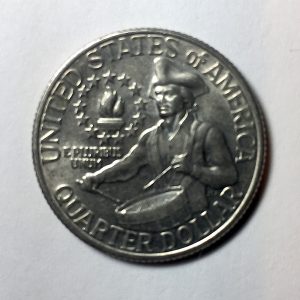
1976 Washington Quarter with my favorite, the Drummer Boy reverse
After the introduction of the Eisenhower Dollar, the first design change came in 1975 for the bicentennial. In the 1970s, celebrating the bicentennial was a significant event. The planning began in the last 1960s and picked up in 1972. The entire nation planned for a celebration that spread across every community.
The American Revolution Bicentennial Administration logo was everywhere, including the official medals the U.S. Mint produced. But that is not all the U.S. Mint produced as part of the bicentennial celebration.
In 1973, Congress passed the law allowing the U.S. Mint to change the reverse design of the quarter, half-dollar, and dollar coins to honor the bicentennial in 1975 and 1976. The coins will be dated 1776-1976 before they revert to their original designs.
My first introduction to a design change was the Drummer Boy reverse on the Washington Quarter. I liked the design more than the original eagle design on the reverse, and it continues to be one of my favorite designs.
As a collector and a newly minted driver, I saved money from my after-school jobs to purchase uncirculated coins and the sets with the bicentennial coins.
In 2001, there was a reunion of the artists who created the designs. Jack Ahr (quarter), Seth Huntington (half-dollar), and Dennis Williams (dollar) attended the celebration. PCGS had the three artists sign labels inserted into slabs with proof versions of the coins they designed. I was able to pick up a set on the aftermarket.
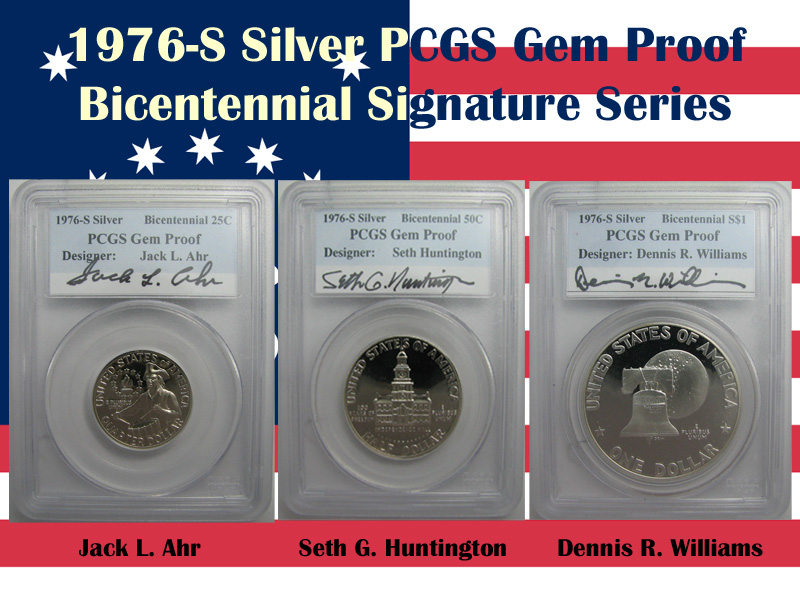
1976-S Silver Proof Bicentennial Autograph Set
Because of the hype, and the potential to increase seigniorage, the U.S. Mint overproduced these coins. They also made proof and silver proof sets so plentiful that they remained on sale through 1986. The U.S. Mint ended up melting over 600,000 sets.
Suggested Reading: To learn more about the legislation that created the Bicentennial coinage program, read “14 Bits: The Story of America’s Bicentennial Coinage” by David Ganz (ISBN 978-0914478638).
The Bicentennial celebration was a national event to remember. Nearly every community issued medals. The Bureau of Engraving and Printing joined in and changed the reverse of the $2 Federal Reserve Note to an interpretation of John Trumbull’s Declaration of Independence. The BEP issued the notes on April 13, 1976, and it is possible to find uncirculated notes postmarked on that date. July 4, 1976, is another popular postmark for bicentennial collectibles, especially postmarks from Philadelphia.
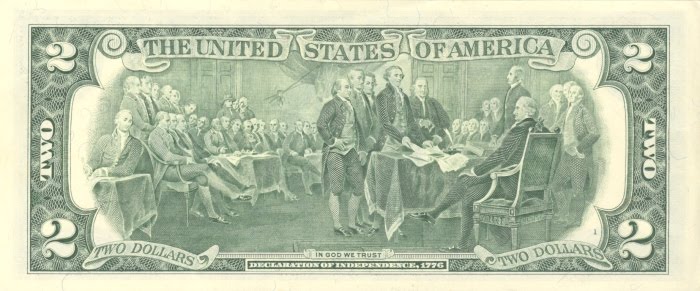
Reverse of the Series 1976 $2 Federal Reserve Note features an engraved modified reproduction of the painting The Declaration of Independence by John Trumbull.
Even though the circulating commemorative was generally successful, the concept would not return until the beginning of the 50 State Quarters program in 1999.
All images are original and property of the author used under the Creative Commons license
CC BY-NC-SA 4.0.
 → Read more at croatiaweek.com
→ Read more at croatiaweek.com
 → Read more at smithsonianmag.com
→ Read more at smithsonianmag.com









